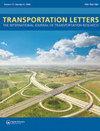Comparison of gap-based and flow-based control strategies using a new controlled stochastic cellular automaton model for traffic flow
IF 3.3
3区 工程技术
Q2 TRANSPORTATION
Transportation Letters-The International Journal of Transportation Research
Pub Date : 2025-08-09
DOI:10.1080/19427867.2024.2417150
引用次数: 0
Abstract
Autonomous vehicles are essential to future transportation systems, potentially reducing traffic congestion. This study examines the impact of different vehicle control strategies on traffic flow through simulations. We propose a novel stochastic cellular automaton model, the controlled stochastic optimal velocity (CSOV) model, which incorporates vehicle control effects. Within the CSOV model, two control strategies are implemented: gap-based control (GC), which adjusts vehicle velocity to balance the gaps between adjacent vehicles, and flow-based control (FC), which aims to maintain a consistent local flow between the front and rear vehicles. Results show that both control strategies improve traffic flow. However, under weaker control, the GC sometimes resulted in lower flow compared to no control. In contrast, the FC consistently enhanced flow across control strengths, yielding more robust outcomes. Furthermore, when both strategies achieved comparable flow rates, the FC provided a more stable velocity distribution under varying traffic densities than the GC.
基于一种新的可控随机元胞自动机模型的基于间隙和基于流量的交通流控制策略的比较
自动驾驶汽车对未来的交通系统至关重要,可能会减少交通拥堵。本文通过仿真研究了不同车辆控制策略对交通流的影响。本文提出了一种新的随机元胞自动机模型——可控随机最优速度(CSOV)模型,该模型考虑了车辆控制效应。在CSOV模型中,实现了两种控制策略:基于间隙的控制(gap-based control, GC)和基于流量的控制(flow-based control, FC),前者通过调整车辆速度来平衡相邻车辆之间的间隙,后者旨在保持前后车辆之间的局部流量一致。结果表明,两种控制策略均能改善交通流量。然而,在较弱的控制下,与没有控制相比,GC有时会导致较低的流量。相比之下,FC持续增强了控制强度的流量,产生了更稳健的结果。此外,当两种策略达到相当的流量时,在不同的流量密度下,FC比GC提供了更稳定的速度分布。
本文章由计算机程序翻译,如有差异,请以英文原文为准。
求助全文
约1分钟内获得全文
求助全文
来源期刊

Transportation Letters-The International Journal of Transportation Research
TRANSPORTATION SCIENCE & TECHNOLOGY-
CiteScore
6.40
自引率
14.30%
发文量
79
审稿时长
>12 weeks
期刊介绍:
Transportation Letters: The International Journal of Transportation Research is a quarterly journal that publishes high-quality peer-reviewed and mini-review papers as well as technical notes and book reviews on the state-of-the-art in transportation research.
The focus of Transportation Letters is on analytical and empirical findings, methodological papers, and theoretical and conceptual insights across all areas of research. Review resource papers that merge descriptions of the state-of-the-art with innovative and new methodological, theoretical, and conceptual insights spanning all areas of transportation research are invited and of particular interest.
 求助内容:
求助内容: 应助结果提醒方式:
应助结果提醒方式:


